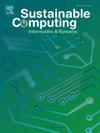Implementation of distributed energy resources along with Network Reconfiguration for cost-benefit analysis
IF 3.8
3区 计算机科学
Q1 COMPUTER SCIENCE, HARDWARE & ARCHITECTURE
引用次数: 0
Abstract
Increased demand of power in distribution networks (DN) driven by various sectors like industrial, commercial, municipal, residential, and irrigation necessitates alternative solutions such as Distributed Generators (DGs), capacitors, and Network Reconfiguration (NR). Addressing this challenge involves optimizing the opening of tie line switches and determining the optimal placement and capacity of capacitors and DGs, which poses a complex optimization problem involving both discrete and continuous variables. To tackle this, an Adaptive Quantum-inspired Evolutionary Algorithm (AQiEA), combining principles from Quantum computing and Evolutionary Algorithms, is employed. This study emphasizes holistic benefits, specifically aiming to maximize economic gains in the distribution system with the installation of DGs, capacitors, and NR along with minimization of power losses. In this paper, two cases are explored. In the first case, seven scenarios’ analyses system losses with load variations, each scenario running twenty-five independent iterations. Performance metrics has been computed to reveal that simultaneous implementation of NR, DGs, and capacitors significantly reduces power losses compared to independent implementations. The second case introduces an additional objective of maximizing economic benefits. This involves considering factors like DG and capacitor location, capacity, line losses, and various costs such as operational, maintenance, and installation costs. The results tabulated in paper demonstrate that operating DGs in parallel with capacitors and NR not only minimizes power losses but also maximizes distribution utilities' profits.
分布式能源的实现以及成本效益分析的网络重构
由工业、商业、市政、住宅和灌溉等各个部门驱动的配电网络(DN)电力需求增加,需要分布式发电机(dg)、电容器和网络重构(NR)等替代解决方案。解决这一挑战需要优化连接线开关的开度,确定电容器和dg的最佳位置和容量,这是一个涉及离散变量和连续变量的复杂优化问题。为了解决这个问题,采用了一种自适应量子启发的进化算法(AQiEA),结合了量子计算和进化算法的原理。本研究强调整体效益,特别是通过安装dg、电容器和NR,使配电系统的经济效益最大化,同时使功率损耗最小化。本文探讨了两个案例。在第一种情况下,七个场景分析了负载变化的系统损失,每个场景运行25个独立的迭代。性能指标的计算表明,与独立实现相比,NR、dg和电容器的同时实现显着降低了功率损耗。第二种情况引入了经济效益最大化的附加目标。这包括考虑DG和电容器位置、容量、线路损耗以及各种成本(如操作、维护和安装成本)等因素。本文的结果表明,将dg与电容器和NR并联运行不仅可以使功率损失最小化,而且可以使配电公司的利润最大化。
本文章由计算机程序翻译,如有差异,请以英文原文为准。
求助全文
约1分钟内获得全文
求助全文
来源期刊

Sustainable Computing-Informatics & Systems
COMPUTER SCIENCE, HARDWARE & ARCHITECTUREC-COMPUTER SCIENCE, INFORMATION SYSTEMS
CiteScore
10.70
自引率
4.40%
发文量
142
期刊介绍:
Sustainable computing is a rapidly expanding research area spanning the fields of computer science and engineering, electrical engineering as well as other engineering disciplines. The aim of Sustainable Computing: Informatics and Systems (SUSCOM) is to publish the myriad research findings related to energy-aware and thermal-aware management of computing resource. Equally important is a spectrum of related research issues such as applications of computing that can have ecological and societal impacts. SUSCOM publishes original and timely research papers and survey articles in current areas of power, energy, temperature, and environment related research areas of current importance to readers. SUSCOM has an editorial board comprising prominent researchers from around the world and selects competitively evaluated peer-reviewed papers.
 求助内容:
求助内容: 应助结果提醒方式:
应助结果提醒方式:


